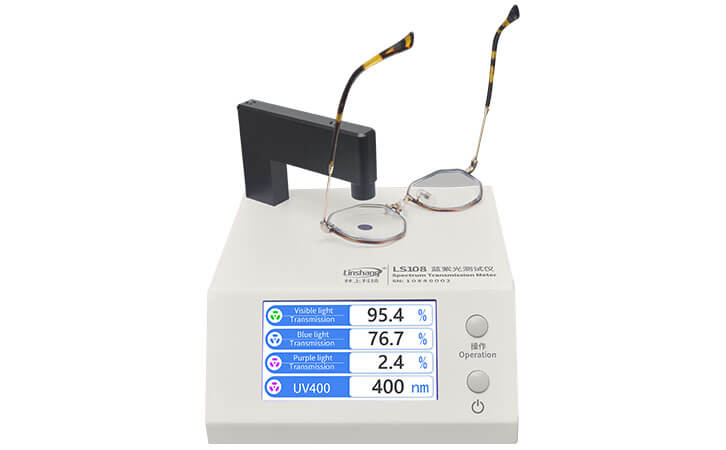How to Test if the Sunglasses have UV400 Protection?
Studies have shown that ultraviolet rays can cause damage to the human eye. Long-term exposure to ultraviolet rays can harden the eyeballs. If this damage is accumulated for a long time, various eye diseases such as macular disease, glaucoma and cataracts will appear. More people are beginning to pay attention to the protection of their eyes and choose to wear sunglasses when they go out, but experts say that not all sunglasses have UV protection. The commonly used "UV400" logo is a standard set for anti-ultraviolet effects. What exactly is "UV400"? How to use spectrum transmission meter to detect sunglasses?
1. What is UV protecction in sunglasses?
When buying sunglasses, it is recommended to check whether there is a "UV400" logo. The "UV400" lenses can block 100% of ultraviolet rays. A pair of qualified sunglasses can completely block ultraviolet rays and have good light transmittance, so as to ensure that the user can identify the surrounding environment well and ensure their own safety when traveling. Not all glasses have the function of anti-ultraviolet radiation. If you wear inferior dark sunglasses, your pupils will be enlarged, which will increase the damage to your eyes caused by ultraviolet rays.

2. UV 400 protection VS UVA/UVB?
(1) What is UV 400?
In short, UV 400 means that the lens will block ultraviolet (UV) light shorter than or equal to 400 nanometers (nm). Of course, all ultraviolet waves have different lengths
(2) What are UVA and UVB?
The sun emits 3 types of UV waves-UV-A, UV-B and UV-C. Both UV-A and UV-B can penetrate the earth. On the other hand, most of the UV-C (most dangerous) is absorbed by the atmosphere.
95% of the ultraviolet light entering the earth is UV-A (this is also the ultraviolet light used in tanning beds). The remaining 5% is UV-B (this is the cause of most sunburns). It has been found that if directly exposed to our eyes, both types of radiation can cause damage.
This is why most experts will tell you why you are looking for sunglasses that can block 100% UV-A and UV-B rays.
3. Why do sunglasses need to have UV protection?
Some optical shops will be equipped with professional spectrum transmission meter, which can detect the blue light/purple light transmittance of sunglasses. The LS108 spectrum transmission meter can measure 395nm transmittance and rejection of spectacle lenses, but why test the transmittance of 395nm ultraviolet light?
Ultraviolet light refers to electromagnetic waves with a wavelength of 10nm-380nm (or 10nm-400nm). The blocking effect of sunglasses on ultraviolet rays of different wavelengths usually decreases with increasing wavelength. This is because the wavelength range of visible light is 380-760nm (or 400-760nm). A pair of qualified sunglasses must have good visible light transmittance. Therefore, sunglasses generally have a poorer UV blocking effect with larger wavelengths. When measuring sunglasses, we can directly detect the ultraviolet (or purple) transmittance at 395nm. If the glasses have a lower ultraviolet transmittance at this wavelength, it also indicates that the transmittance to other wavelengths is lower. Taking the European standard as an example, when using the LS108 spectrum transmission meter for testing, if the UV lens has a UV transmittance of 395nm of less than 0.5%, it indicates that the lens has a UV400 effect.
4. How to tell if the sunglasses have UV protection?
The transmittance of ultraviolet light at 395 nm is now measured, which is only 1.8%, which means that 98.2% of violet light at 395 nm is blocked. According to the introduction above, we know that this sunglasses lens will have a lower transmittance for shorter wavelength ultraviolet rays, so this lens has a good ultraviolet blocking effect. LS108 light transmission meter can also be set to rejection rate mode. The meter can test visible light transmission, blue light/ ultraviolet rays rejection and UV 400.
If you need to measure the light transmittance and anti-blue light effect of the lens, you can also move the lens to the left. When measuring, please make sure that the center of the lens is aligned with the test hole to reduce the influence of the lens edge curvature on the test data.
The current standards in China have no strict requirements on the anti-ultraviolet effect of sunglasses and only require that the glasses are harmless to the wearer after wearing the glasses. Therefore, sunglasses in many eyewear stores may not reflect the UV protection effect of the sunglasses through the logo. When purchasing sunglasses, if the lens does not have the "UV400" logo, you can also use the spectrum transmission meter by the optician to test the lens.
- Features of the LS183 UV Transmittance Meter
- Difference between Visible Light Transmission Meter LS183 and LS108H
- Spectacle lens anti-blue light detection---blue-violet light transmittance meter
- Spectrum Transmission Meter for Measuring PC Sheet
- Difference between LS103A and LS183 spectrum transmission meter
- Measuring the Transmittance of a Hemisphere by Plastic Transmittance Meter

